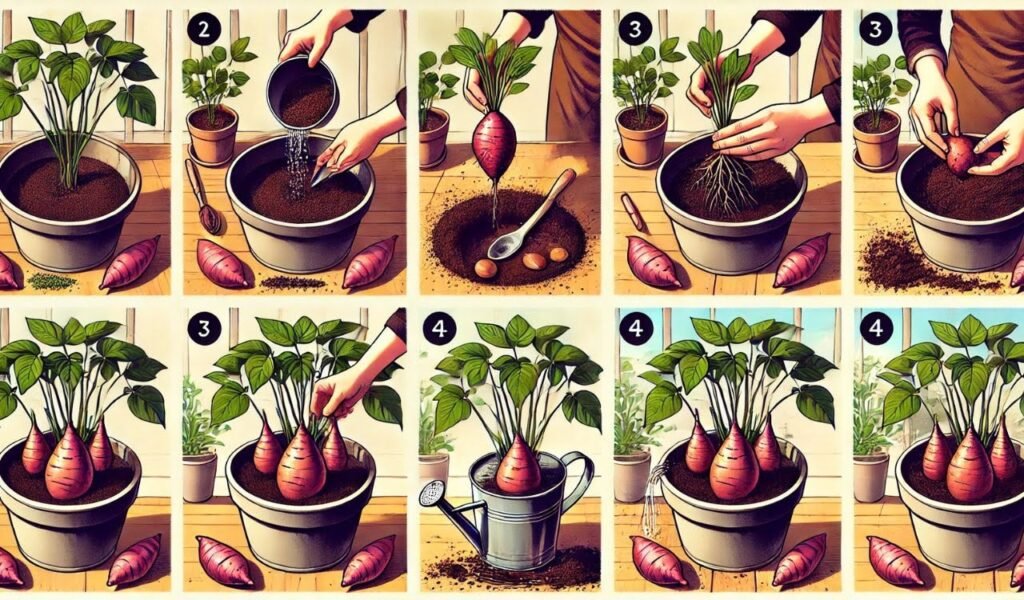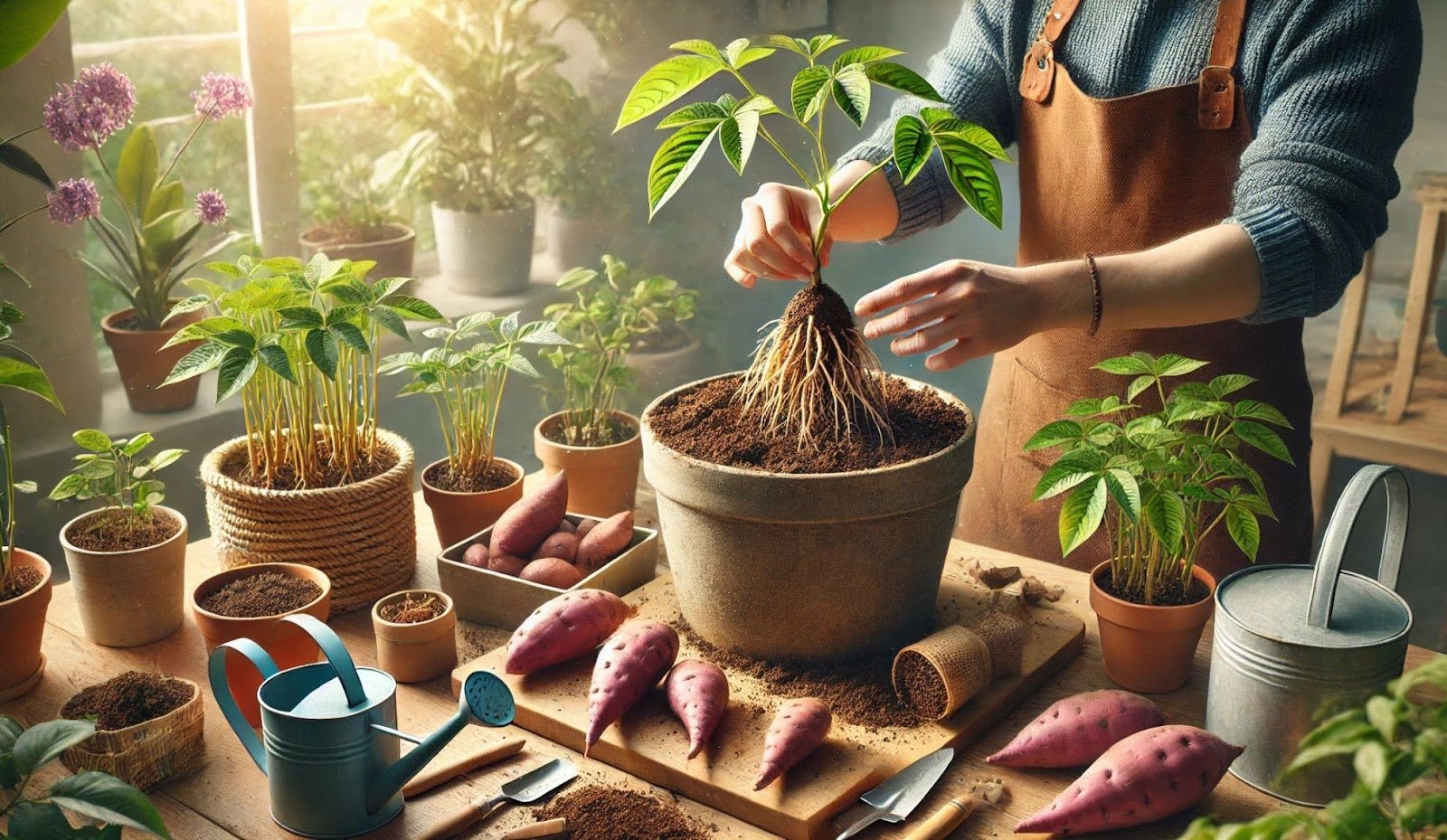Planting Sweet Potatoes in Pots: How to Maximize Your Harvest
Planting sweet potatoes in pots is easier than you think, and you don’t need a huge garden to do it. With the right container, soil, and a little patience, you can grow delicious, homegrown sweet potatoes on your patio, balcony, or even indoors. No digging, no backbreaking work—just fresh, organic tubers right at your fingertips. The best part? Harvesting is as simple as tipping over a pot! Ready to learn the secrets to a bountiful sweet potato harvest? Let’s dive in!
Why Should You Grow Sweet Potatoes in Pots?
Planting sweet potatoes in pots is an excellent option for many reasons. First and foremost, it allows anyone to grow them, no matter how much (or how little) space they have. If you live in an apartment with only a balcony, you can still enjoy a bountiful harvest without the need for a traditional garden bed. Another major advantage is soil control.
Sweet potatoes thrive in loose, well-draining soil, which can be tricky to achieve in regular garden beds, especially if you have compacted or clay-heavy soil. With containers, you have complete control over the growing medium, ensuring your sweet potatoes get the best possible environment. Pest control is another huge plus. Since sweet potatoes are prone to soil-borne diseases and nematodes, growing them in containers helps reduce the risk of infestations.
Plus, you won’t have to worry about underground pests like voles or grubs feasting on your tubers before you do! And let’s not forget about harvest time. Unlike in-ground planting, where you have to carefully dig through the soil to find your sweet potatoes (often damaging them in the process), container gardening makes harvesting super simple. When your sweet potatoes are ready, you just dump out the soil and collect your beautiful homegrown tubers—no digging required!
Choosing the Right Container for Sweet Potatoes
Sweet potatoes have a deep root system, so choosing the right container is essential. You’ll want something at least 12-18 inches deep and 15-20 inches wide to give the roots enough space to develop. If your container is too small, the roots will become crowded, leading to smaller tubers. There are several options when it comes to choosing a container.
Plastic or ceramic pots are a great choice since they hold moisture well, but you’ll need to ensure they have drainage holes to prevent waterlogging. Fabric grow bags are another fantastic option because they provide excellent aeration and drainage, preventing root rot.
If you’re looking for a more rustic look, wooden barrels or large buckets can also work well. The key is ensuring that whatever container you choose has proper drainage. Without it, water will pool at the bottom, leading to root rot and ruining your crop.
The Best Soil for Planting Sweet Potatoes in Pots
Sweet potatoes love light, well-draining soil that is rich in organic matter. If the soil is too compact, the roots will struggle to expand, leading to small, misshapen tubers. The best approach is to create a mix that provides the perfect balance of nutrients, aeration, and moisture retention.
A great soil mix consists of:
- High-quality potting soil for structure and drainage
- Compost or aged manure to add nutrients
- Sand or perlite to improve aeration and prevent compaction
You should also pay attention to the pH level, as sweet potatoes prefer slightly acidic to neutral soil, with a pH range of 5.5 to 6.5. Avoid using heavy garden soil or clay-based soil, as they retain too much moisture and restrict root growth.
How to Grow Sweet Potatoes in Pots

Step 1: Preparing Sweet Potato Slips
Unlike regular potatoes, which are planted as whole tubers, sweet potatoes are grown from slips—sprouts that grow from mature sweet potatoes. You can buy slips from a nursery or grow your own at home. To grow your own slips, start with a healthy, organic sweet potato (avoid store-bought ones that have been treated with sprout inhibitors). Place the sweet potato half-submerged in a jar of water, keeping the pointed end down.
In 2-3 weeks, you’ll notice green shoots sprouting from the top. Once these slips reach 4-6 inches in length, carefully twist them off the sweet potato and place them in a separate jar of water. Within 5-7 days, you’ll see tiny roots forming at the bottom. Once these roots are about an inch long, your slips are ready for planting.
Step 2: Mix Fertilizer With Organic Media
Sweet potatoes are heavy feeders so you should mix in a balanced vegetable fertilizer prior to planting, such as 10-10-10. If you plan to use an organic fertilizer, take into account that most organic fertilizers have lower N-P-K numbers (2-2-2 or 5-5-5) and thus less percentage of nutrients per lb of fertilizer.
You may have to reapply organic fertilizers once or twice during the growing season to supply enough nutrients for a healthy crop. For any fertilizer, follow the directions as listed on the bag for application rates and how often to apply.
Step 3: Planting the Slips in the Container
Now that your slips are ready, it’s time to plant them! How far apart should you plant sweet potatoes in a pot? Since space is limited in a container, it’s best to plant 1-2 slips per 15-gallon container or space them 10-12 inches apart in larger containers.
Fill your container with the prepared soil mix, leaving about 2 inches of space at the top. Dig a 4-inch hole, place the slip inside, and cover the roots completely with soil, leaving the leaves above the surface. Gently pat the soil down and give the plant a good watering.
Step 4: Be Proactive For Deer and Rabbits
Sweet potato greens are edible and delicious, and the deer and rabbits know it! Have a plan for keeping the critters out of your container garden. A bite here or there will not damage your plant, nor does careful harvesting of greens for yourself. However, most critters eat indiscriminately and nibble off more than is healthy for the plant’s growth.
Bold rabbits will even stand on their hind legs to nibble greens out of tall containers. Deer will eat every single leaf off the plants, leaving only the stems. This amount of damage will set your plants back considerably.
Step 5: Watering and Sunlight Requirements
Sweet potatoes love warmth and sunlight. Make sure your container is placed in a spot that gets at least 6-8 hours of direct sunlight daily. If you’re growing indoors, place the pot near a south-facing window or use a grow light to supplement light.
When it comes to watering, keep the soil moist but not soggy. Sweet potatoes need consistent moisture, especially in the early stages, so water 2-3 times per week. As the plants mature, reduce watering slightly to prevent rot.
How Long Does It Take to Grow Sweet Potatoes?
Sweet potatoes take 90-120 days to mature, depending on the variety and growing conditions. For the first few weeks, the slips will focus on developing strong roots and vines. Around the 6-8 week mark, tubers will start forming underground. By the 12-16 week mark, your sweet potatoes should be ready to harvest.
How Far Apart to Plant Sweet Potatoes
When planting sweet potatoes, giving them enough space is key to growing healthy, full-sized tubers. Each sweet potato slip should be spaced about 12 to 18 inches apart within the row to allow the roots to develop freely and the vines to spread without overcrowding. Between rows, aim for 3 to 4 feet of space so the vines have room to sprawl and air can circulate, which helps prevent disease and makes it easier to weed and harvest later on.
Sweet potatoes love to grow, and if they’re packed too tightly, they’ll end up competing for water, nutrients, and sunlight—often leading to smaller, stunted tubers. Planting them with enough breathing room sets them up for success.
If you’re working with heavy or poorly draining soil, consider using raised beds or mounded rows to improve drainage and make root development easier. A little planning with spacing goes a long way in making sure your sweet potato patch is both manageable and productive.
How Many Sweet Potatoes Per Plant?
Each slip typically produces 3-6 sweet potatoes, but in a large container, you can expect a total of 5-10 tubers per pot. Factors like soil quality, watering, and sunlight exposure will affect yield.
Planting Purple Sweet Potatoes
Planting purple sweet potatoes is very similar to planting the more common orange varieties, but with the added bonus of vibrant color and slightly nutty flavor. Start by purchasing slips, which are young shoots grown from mature tubers, and plant them in loose, well-drained soil after the danger of frost has passed and the soil has warmed to at least 60°F.
Choose a sunny location, and space the slips about 12 to 18 inches apart in rows that are 3 to 4 feet apart to give the vines plenty of room to spread. Purple sweet potatoes thrive in raised beds or mounded rows, which help prevent waterlogging and encourage better root development.
Keep the soil consistently moist during the growing season, especially during the first few weeks as the plants get established. With about 100 to 120 days of warm weather, your purple sweet potatoes will be ready to harvest once the leaves begin to yellow and die back in the fall.
Harvest Before Frost
Plan on not watering before harvesting, since dry soil makes for easier harvest. Sweet potatoes are not frost-tolerant at all. Harvest them at the latest time possible in the fall before frost hits. Plus, the greens are edible, so harvest them before they are frost-killed. If a fall frost kills the greens completely before you have harvested the tubers, you need to dig them immediately before the frost-kill travels down into the tuber.
It is best to harvest before soil temperatures fall below 55 degrees Fahrenheit. This could potentially occur before a frost. This is especially true in container-grown sweet potatoes, so pay attention to the weather as harvest time nears. Dig the potatoes if the soil in your container gets too cold.
Time to Cure

After digging, do not leave the dug tubers out in the direct sun, or outside overnight in case of chilling injury. Do not wash them. They need to be cured after harvest. This simply means allowing their skins to dry, which helps them store longer.
Also, if you have any potatoes that were cut or scraped during harvest, curing will dry up the area. Sweet potatoes are best cured at 80 to 90 degrees fahrenheit, with adequate ventilation and 85% to 90% humidity. This can be a bit of a challenge to achieve this warm, humid environment at home.
If you have warm fall days and live in a humid climate, a screened porch or warm, open garage can work as long as you move the potatoes indoors at night in case of freezing. Or, use the warmest room in your house and know you are doing your best! They will still cure, though it may take longer than if they were at optimal curing conditions.
After curing, the ideal storage temperature is 60 degrees fahrenheit. A basement room with good ventilation can work just fine. Enjoy your harvest all winter long!
FAQ
Can sweet potatoes be grown indoors in pots?
Yes! As long as they receive 6-8 hours of sunlight or are supplemented with grow lights, they can thrive indoors.
How deep should a pot be for sweet potatoes?
A pot should be at least 12-18 inches deep and 15-20 inches wide to allow proper root development.
How far apart should I plant sweet potatoes in a pot?
Plant 1-2 slips per 15-gallon container or space them 10-12 inches apart in larger pots.
How often should I water sweet potatoes in containers?
Water 2-3 times per week, keeping the soil moist but not soggy, and reduce watering before harvest.
How long does it take for sweet potatoes to grow in pots?
Sweet potatoes take 90-120 days to fully mature, depending on the variety and growing conditions.
How to cut sweet potato slips for planting?
Cut sweet potato slips when they’re 5–6 inches long by snipping them off at the base of the sprout, close to the potato.
Do sweet potato plants need fertilizer?
Use a low-nitrogen fertilizer to encourage root growth rather than excessive vine growth.
How many sweet potatoes per plant?
Each sweet potato plant typically produces 3 to 5 mature sweet potatoes.
Final Thoughts
Planting sweet potatoes in pots is not only possible but also fun and rewarding. Whether you’re a backyard gardener or working with a small indoor space, you can enjoy homegrown sweet potatoes with the right container, soil, and care. So why not start today? You’ll be digging into your very own delicious sweet potatoes in just a few months!







